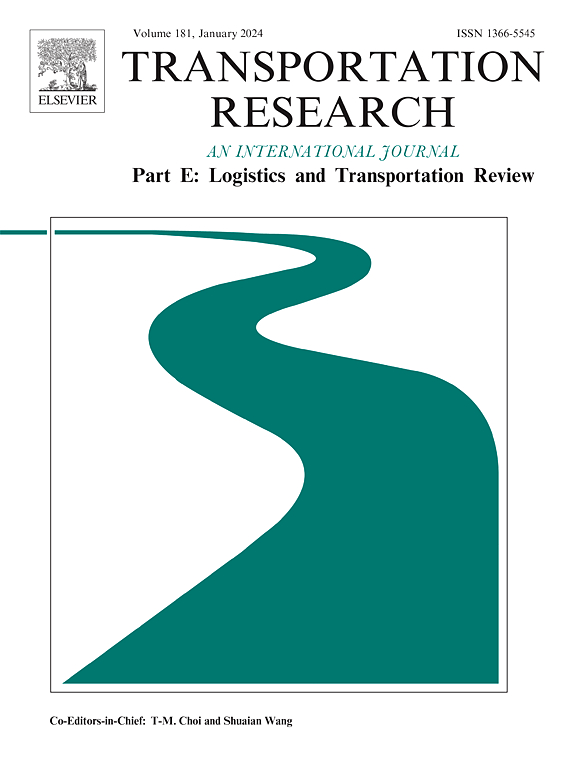Identification of critical sets of ports in cascading failures of global liner shipping network
IF 8.8
1区 工程技术
Q1 ECONOMICS
Transportation Research Part E-Logistics and Transportation Review
Pub Date : 2025-06-03
DOI:10.1016/j.tre.2025.104184
引用次数: 0
Abstract
Cascading failures of port congestion propagation have become increasingly frequent in the global liner shipping network (GLSN), which harms international trade. To build resilience in maritime logistics, it is vital to proactively identify critical port sets whose initial failure would trigger severe consequences of port congestion propagation. This paper proposes a methodology for critical port sets identification in the cascading failures of GLSN, which integrates a cascading failure simulation model with a meta-heuristic optimization procedure. Specifically, a cascading failure model that considers liner shipping service routes’ port rotation adjustment behavior is introduced first. Then, the identification of critical port sets is formulated as a combinatorial optimization problem, seeking sets of ports whose simultaneous initial disruptions would trigger the largest cascade size; and an improved multi-population genetic algorithm is developed to solve this optimization problem. We demonstrate the usefulness of the proposed methodology by applying it to an empirical case of the GLSN, identifying the top 10 most critial sets of ports under different given values of set size. Extensive computational experiments validate the algorithm’s effectiveness in delivering high-quality solutions of approximate optimality. Results show that the critical sets of ports and their triggered cascade sizes are largely influenced by the service route behaviors of port rotation adjustments, and the influence becomes more profound with the increase in set size. Our proposed methodology serves as a valuable tool for proactively identifying worst-case scenarios of global port congestion propagation, thereby assisting stakeholders in resilient maritime logistics management.
全球班轮运输网络级联故障中关键港口组的识别
在全球班轮运输网络中,港口拥塞传播的级联故障日益频繁,给国际贸易带来了危害。为了在海上物流中建立弹性,主动识别关键港口集至关重要,这些港口集的初始故障将引发港口拥堵传播的严重后果。本文提出了一种将级联故障仿真模型与元启发式优化过程相结合的GLSN级联故障关键端口集识别方法。具体来说,首先引入了考虑班轮航线港口旋转调整行为的级联失效模型。然后,将关键端口集的识别表述为组合优化问题,寻求同时初始中断将触发最大级联规模的端口集;并提出了一种改进的多种群遗传算法来解决这一优化问题。我们通过将所提出的方法应用于GLSN的经验案例来证明其有效性,确定了不同给定集大小值下的前10个最关键的端口集。大量的计算实验验证了该算法在提供高质量近似最优解方面的有效性。结果表明,港口旋转调整的业务路由行为对港口关键集及其触发级联大小有较大影响,且随着集大小的增加,影响更为深刻。我们提出的方法是一种有价值的工具,可以主动识别全球港口拥堵传播的最坏情况,从而帮助利益相关者进行弹性海上物流管理。
本文章由计算机程序翻译,如有差异,请以英文原文为准。
求助全文
约1分钟内获得全文
求助全文
来源期刊
CiteScore
16.20
自引率
16.00%
发文量
285
审稿时长
62 days
期刊介绍:
Transportation Research Part E: Logistics and Transportation Review is a reputable journal that publishes high-quality articles covering a wide range of topics in the field of logistics and transportation research. The journal welcomes submissions on various subjects, including transport economics, transport infrastructure and investment appraisal, evaluation of public policies related to transportation, empirical and analytical studies of logistics management practices and performance, logistics and operations models, and logistics and supply chain management.
Part E aims to provide informative and well-researched articles that contribute to the understanding and advancement of the field. The content of the journal is complementary to other prestigious journals in transportation research, such as Transportation Research Part A: Policy and Practice, Part B: Methodological, Part C: Emerging Technologies, Part D: Transport and Environment, and Part F: Traffic Psychology and Behaviour. Together, these journals form a comprehensive and cohesive reference for current research in transportation science.

 求助内容:
求助内容: 应助结果提醒方式:
应助结果提醒方式:


